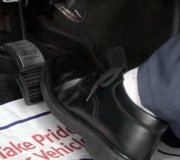Hi,
It sounds like there is trapped air in the ABS. What I would suggest is trying the automated bleed procedure with a scan tool. Here are the directions. Note that the automated bleed procedure doesn't start until towards the end of the directions (#10).
Based on your description, this is what I feel needs done.
Here are the directions:
2003 GMC Truck S15/T15 Sonoma P/U 2WD V6-4.3L VIN X
ABS Automated Bleed Procedure
Vehicle Brakes and Traction Control Hydraulic System Brake Bleeding Service and Repair Procedures ABS Automated Bleed Procedure
ABS AUTOMATED BLEED PROCEDURE
ABS Automated Bleed Procedure
Two - Person Procedure
Important:
Use the two-person bleed procedure under the following conditions:
- Installing a new Electro-Hydraulic Control Unit (EHCU) or new Brake Pressure Modulator Valve (BPMV).
- Air is trapped in the valve body.
Do not drive the vehicle until the brake pedal feels firm.
- Do not reuse brake fluid that is used during bleeding.
- Use the vacuum, the pressure and the gravity bleeding procedures only for base brake bleeding.
1. Raise the vehicle in order to access the system bleed screws.
2. Bleed the system at the right rear wheel first.
3. Install a clear hose on the bleed screw.
4. Immerse the opposite end of the hose into a container partially filled with clean DOT 3 brake fluid.
5. Open the bleed screw 1/2 to 1 full turn.
6. Slowly depress the brake pedal. While the pedal is depressed to its full extent, tighten the bleed screw.
7. Release the brake pedal and wait 10-15 seconds for the master cylinder pistons to return to the home position.
8. Repeat the previous steps for the remaining wheels. The brake fluid which is present at each bleed screw should be clean and free of air.
9. This procedure may use more than a pint of fluid per wheel. Check the master cylinder fluid level every four to six strokes of the brake pedal in order to avoid running the system dry.
10. Press the brake pedal firmly and run the Scan Tool Automated Bleed Procedure. Release the brake pedal between each test.
11. Bleed all four wheels again using Steps 3-9.
This will remove the remaining air from the brake system.
12. Evaluate the feel of the brake pedal before attempting to drive the vehicle.
13. Bleed the system as many times as necessary in order to obtain the appropriate feel of the pedal.
_________________________________
I hope this helps. Let me know if you have other questions.
Take care and God Bless,
Joe
Tuesday, February 23rd, 2021 AT 5:29 PM



